Unusual coins
According to What is a Coin?, "A coin is a piece of hard
material, traditionally metal and usually in the shape of a disc, which is used as a form of
money." However not all coins are round. As a matter of fact, several countries have issued a variety of
odd-shaped coins which many collectors find attractive enough to purchase and cherish them. Round coins continue
to be the norm in modern coinage, as they are less prone to wear and are most easily mass-produced.
nevertheless, some fifty nations have issued nonround coins for circulation and commemorative purposes.
Oval coins
When built, the steamship RMS Titanic was the largest moving object on the planet. It was
touted as being unsinkable, until it sunk on its maiden voyage after striking an iceberg on the night of April 14,
1912, with a loss of over 1500 lives. In 1985 the wreck was finally located. During the diving expedition of 2000
pieces of coal were recovered from the wreck. To commemorate the ship and the recovery, Liberia issued this oval
silver Proof 10 Dollar coin. The coin depicts the doomed ship, with a small piece of coal from the Titanic
incorporated into the coin at coal bunker section of the ship. The reverse of the coin shows the arms of
Liberia. The coin is dated 2005 and has a mintage of only 5000 pieces.
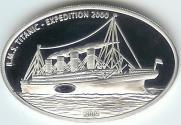
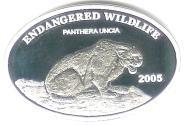
This Mongolian coin is quite unusual. It is the world's first bi-metal coin composed of a
irregularly Niobium center and sterling silver. It pictures a crouching Mongolian Snow Leopard. The Leopard is
Niobium, a bluish metal. It is surround by an oval "ring" of sterling silver. The reverse of the coin features
the countries arms, and of course, the outline of the Niobium leopard "plug". The coin has a nominal face value
of 500 Tugrik and is Proof. This unusual coin has a mintage of only 5000 pieces.
Scalloped-edges
Flower-shaped coins are also common, like the aluminum 10-poisha coin from Bangladesh that featured a scalloped
shape from 1973 to 1984. In 2003 the Cook Islands issued a very unusual set containing (among other odd shapes)
the scalloped-edged 1-dollar coin featuring the recent, frumpy, Ian Rank-Broadley portrait of Queen Elizabeth on
the obverse side and the very well-endowed fertility God Tangaroa on the reverse
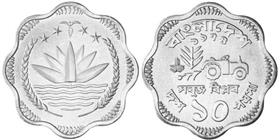
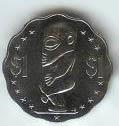
In Europe, Spain's 50-peseta coins first featured a scalloped shape in 1990 and each year between 1990 and 1998
carried a new circulating commemorative design. The Republic of Tanzania issued a scalloped-edge nickel-brass
10-senti coin from 1977 to 1984 featuring a zebra. Israel's copper-nickel agorah coins from 1960 to 1980 feature a
scalloped edge and a wheat design on their obverses. Swaziland has issued a number of scalloped-edge coins in
cent, 2-cent, 5-cent, 10-cent and 20-cent denominations. Some 2-cent issues, instead of a scalloped edge, bear
a somewhat square shape with rounded corners. The Maldives has issued a number of scalloped-edge coins, both as
a sultanate and as a republic. The 5- and 10-larin issues depict a variety of designs, including national emblems,
bonito tuna, a sailing ship and a mosque, and are composed of either nickel-brass or aluminum. The kingdom of
Bhutan issued aluminum scalloped-edge coins in 1974 and 1975 denominated 10 chetrums.
Trianglular coins
Bermuda trades upon the so-called Bermuda Triangle with its triangular dollar coins. Queen Elizabeth II's
portrait appears on their obverses and shipping scenes on their reverses. The Bermuda's Proof 1998 sterling
silver $3 coin is struck on a rectangular planchet and the reverse depicts the ship Deliverance sailing toward
the island nation. In 2003 the Cook Islands issued a very unusual set containing (among other odd shapes) the
triangular 2-dollar coin featuring the recent, frumpy, Ian Rank-Broadley portrait of Queen Elizabeth on the
obverse side and a ceremonial table and a bottle on the reverse.
Square-rectangular, pentagonal and hexagonal coins
Special-edition klippe coins to commemorate the 10th anniversary of the National Bank of Poland putting a new
coinage system into circulation were struck by the Polish State Mint. Klippe coins are usually square or
rectangular in shape and are reminiscent of the centuries-old European silver coins, like the 1627 Transylvania
2-taler klippe shown below. Two nonround gold issues are the hexagonal-shaped Augustus Humbert $50 gold slug,
top, and the octagonal 1915-S Panama-Pacific Exposition $50 gold coin.
Leonardo Da Vinci's famed Equestrian statue is featured on this pair of square silver 500 Tugrik
coins from Mongolia. The statue, now in Budapest, Hungary, is the only known original surviving sculpture by Da
Vinci. Both coins have the same design, depicting one side of the sculpture on one side of the coin and the other
side of the sculpture on the other side of the coin. There are two versions of the coin. One version comes with
an antique finish and depicts the sculpture in bronze. The other version has a Proof finish and depicts the
sculpture in gold. Both coins are 35mm x 35mm and are dated 2005. They each contain 1 ounce of .999 fine silver
and have a mintage of only 2500 pieces.

The University of Riga was founded on October 14, 1862, and it was the first of its kind in the Russian Empire. In 2012,
Latvia issued a 1 lats coin to celebrate the 150th anniversary of the founding of the University. The square coin is made
of .925 silver and weighs 26 grams. It was designed by Kristaps Ģelzis (minted by the Mint of Finland) and has two
special features:
- it can be dismantled into two pieces
- it has a hologram (moving the coin one can see the dates 1862 and 2012)
Rectangular coins are much less common than square- or diamond-shaped coins, and most of the rectangular
coins are higher priced than their angular counterparts. Tonga issued a few rectangular pa'anga coins in the late
1970s and early 1980s. The coins were struck in copper-nickel and in .999 fine silver versions. Aruba issued two
square-shaped denominations. Its 50-cent and 5-florin coins are composed of nickel-bonded steel. The 50-cent
coin's obverse carries the country's crest and the reverse carries a geometric design. The 5-florin coin's reverse
carries a portrait of Dutch Queen Beatrix, and the reverse carries a design similar to the 50-cent coin's obverse.
The Netherlands issued zinc square 5-cent coins from 1941 to 1943, Swaziland also issued square 2-cent coins
between 1974 and 1982, and Yemen struck pentagonal coins in the 1940s and 1950s.
Polygon-shaped coins
A number of the United Kingdom's 50-pence coins are seven-sided, including this commemorative piece marking the
British Presidency of the European Council of Ministers. The United Kingdom has used this shape in its 20-pence
coins since 1985 and since 1969 for its 50-pence coins. The 20-pence design features the Tudor rose on its reverse,
topped by a crown. In 2003 the Cook Islands issued a very unusual set containing (among other odd shapes) the
12-sided 5-dollar coin featuring the recent, frumpy, Ian Rank-Broadley portrait of Queen Elizabeth on the obverse
side and a conch shell on the reverse.
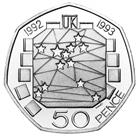
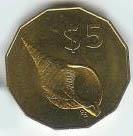
Many countries that currently have or used to have ties to the United Kingdom have also issued
seven-sided coins. Such countries include the Isle of Man, Jersey, Ireland, Papua New Guinea, Uganda, Barbados and
Gibraltar. Still other countries have struck six-, eight- or 10-sided coins. Chile's circulation peso and
5-peso coins have eight sides. A portrait of national hero Bernardo O'Higgins appears on the obverse, and the
reverse features a wreath and the face value. The peso coin is made from aluminum, while the 5-peso coin is
composed of aluminum-bronze.
Hong Kong's 1976 to 1979 $5 copper-nickel coin is 10-sided, Argentina has also issued several octagonal and
12-sided coins, Canada has issued the 11-sided Loon dollar since its introduction in 1987 and also boasts a number
of cent and 5-cent issues that are 12-sided, the Republic of Tanzania issued a 12-sided 5-senti coin from 1966
through 1984 featuring a sailfish design, and Swaziland issued a 12-sided bronze cent in 1975 as a commemorative
for the world Food and Agriculture Organization (there are also several 12-sided 50-cent coin issues).
Other shapes
A fan-shaped Proof sterling silver 10-zloty commemorative coin marking the occasion of the World Exhibition
Expo 2005, held in Aichi, Japan, was issued in March by the National Bank of Poland. For the occasion of the Euro 2012
football championship, the host countries (Poland and Ukrain) also issued some odd shapred silver coins in 10.000 pieces.
Finally, another curious piece for the Euro 2012 football championship is 4 pieces of 10 zloty coins that fit together
to form a flag!
The most oddly shaped coin has to be the .999 fine silver 2002 $10 issue from the Republic of Nauru, an island
republic located in the western Pacific Ocean. The Proof coin celebrates the introduction of the euro with a coin
shaped in the outline of the nations that comprise the European Economic Union.
The silver Proof 5000 Kwacha coin issued by Zambia to commemorate the 2000 Sydney Olympics is one of the
strangest shaped coins ever issued. The unusual coin was made in the shape of the conjoined maps of Australia and
Zambia. Though Australia is approximately ten times the size of Zambia, the two are shown to be roughly the same
area on the coin, and while northern Zambia is attached to Northern Australia, the countries are halfway around
the world from each other! The large size coin is approximately 49mm x 42mm and contains approximately one troy
ounce of silver.
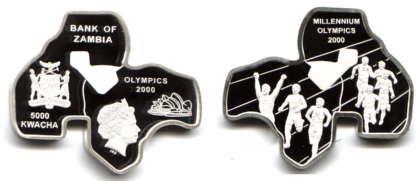
Somali Republic's 2004 commemorative dollar coin is shaped like a guitar to mark the 50th anniversary of rock
and roll music and the Stratocaster guitar. The non-denominated side, left, is enameled. The multi-colored Guitar
coins have proved unbelievably popular with coin collectors, guitar enthusiasts, Rock 'n Roll fans and the general
public. They are designed after famous electric guitars, including the classic red and white Fender Stratocaster,
an American Flag Stars and Stripes Gibson Flying V, a black Gibson Flying V, a pink star Guitar used by various
rock stars including Gary Glitter and Abba, a blue Gibson X-Plorer and a yellow Klein. The coins are 1 Dollar
legal tender coins and they are approximately 45mm (1.75 inches) long.
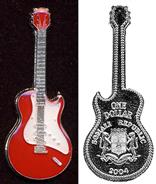
Many other countries have issued diamond-shaped coins. The Bahamas' 15-cent coins are
diamond-shaped. First issued in 1966, the coins feature Queen Elizabeth II's portrait on the obverse and a
hibiscus on the reverse. Bhutan, India, Myanmar, the Netherlands, Oman and Pakistan are among other countries that
have released circulating diamond-shaped coins.